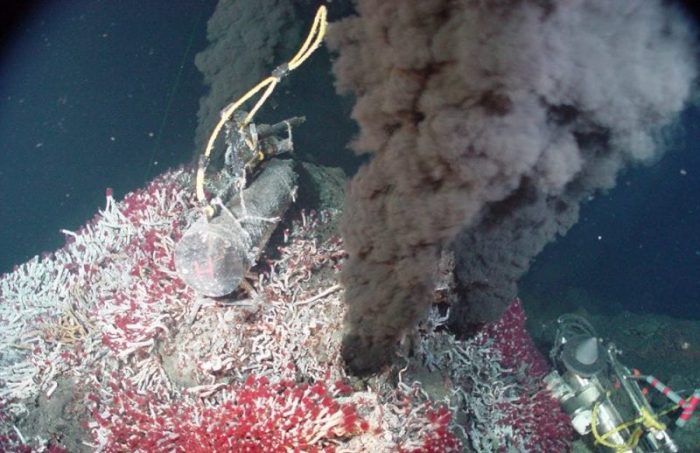
Welcome to the My Science Life feature of Dr. John W. Jamieson, Assistant Professor and Canada Research Chair in Marine Geology at Memorial University of Newfoundland.
I am an Economic Geologist that specializes in marine mineral resources and seafloor hydrothermal systems. I grew up in Edmonton, Alberta.
- B.Sc. (Honours Geology) – University of Alberta
- M.Sc. (Geology) – University of Maryland
- Ph.D. (Geology) – University of Ottawa
Prior to starting my position at Memorial University (in 2016), I was a research scientist at GEOMAR Helmholtz Centre for Ocean Research, in Kiel, Germany.
What is your job like on a daily basis?
I spend ~¾ of the year at Memorial University, in St. John’s, working in my office or lab, and also teaching. I normally teach one graduate level class (Seafloor Hydrothermal Systems), and a senior undergraduate class (Advanced Economic Geology). I currently have 5 students (soon to be 6) working in my lab, so I spend quite a bit of time with my students. I also have several administrative and committee obligations. I also have to find the time to do my own research. So a typical day involves spending time in my office or in my lab, with the odd meeting here and there.
The other ¼ of the year is usually spent traveling. I spend anywhere from 6-12 weeks at sea onboard research vessels. I collaborate with researchers from around the world, and therefore travel for meetings and conferences is also required.
Tell us about your research
My research focuses on the formation of mineral deposits on the seafloor. Specifically, I study “submarine hydrothermal systems”, more commonly referred to as “black smokers”, which are hot water vents that form on the seafloor along tectonic plate boundaries. These hot water vents form mineral deposits (called “seafloor massive sulfide” deposits) that are rich in valuable metals such as copper, zinc, gold, and silver.
Several mineral exploration companies and national governments are interested in mining these deposits directly from the seafloor. The aim of research is to understand the how these deposits form, their size, composition, how quickly they form and how do we find them. This work has implications for the potential for mining the seafloor, including the economic viability and environmental implications.

Black smoker hydrothermal vent (NOAA)
Data collection involves planning and participating on research cruises. We use manned submersibles (e.g., Alvin), though more commonly we now use remotely-operated vehicles (ROVs) and autonomous underwater vehicles (AUVs) to map and obtain images of the seafloor and to collect rock samples. Rock samples are brought back to the lab on shore. We do mineralogical, geochemical and isotopic analyses on these samples. We measure the abundance of certain radioisotopes in order to determine the ages of the samples.
In the end, I consider myself an explorer. Every research cruise takes us to places that no human has ever set eyes on before. We have barely scratched the surface in terms of mapping the seafloor. We have MUCH better maps of the Moon and Mars. Every time we dive to the seafloor we find new things, be it animal species or rock formations…
What are some of the biggest challenges in your field?
The biggest challenge is collecting data and samples. We know VERY little about the ocean floor because it is so inaccessible and such a harsh environment due to the immense pressures. Therefore very specialized equipment is needed. Research cruises are both expensive and technically challenging, and we are always at the mercy of the weather. As a result, research cruises are almost always multi-disciplinary, with several research groups with research goals that are often different, but complementary. Therefore, significant planning is needed to insure that the time spent at sea is optimized to maximize the amount of data collected because there are rarely second chances to return to the same place twice.
What advice do you have to those pursuing a career in your field?
My advice to those wanting to pursue a career in science is to find a topic that really interests you. There is still so much about our own planet that we don’t understand. I also encourage young scientists to make sure they spend the time to learn the fundamentals – math, physics, chemistry… as a first year student in university, I underestimated how useful all of those classes would be later on in my research career. Finally, you never know where a career path in science will take you: the Canadian Space Agency recently announced that they are hiring two new astronauts, and I made the short-list, largely due to my experience as a marine researcher and explorer. (I wasn’t selected in the end…)
The ‘My Science Life’ project is a core part of Science Trends’ mission to give a voice to scientists and allow them to connect with tens of thousands of people. It is an opportunity for people, like yourself, to share their “story” and in doing so, make science more approachable and personal.
Interested in being part of the My Science Life project? You can find the details about submission here.









